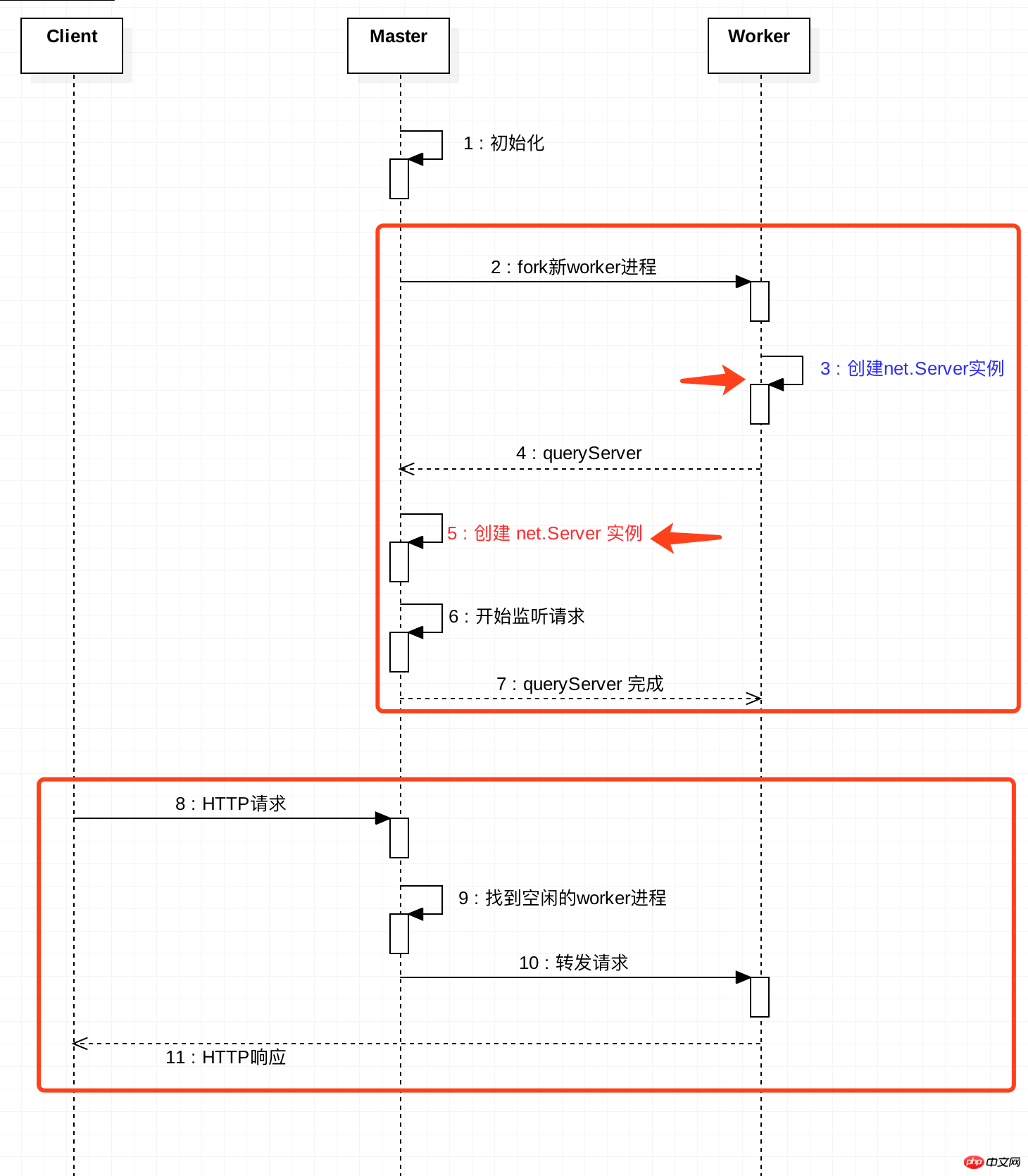Home > Article > Web Front-end > Analyzing the use of Node.js cluster module in detail
This time I will bring you an analysisNode.js Detailed explanation of the use of cluster module, detailed explanation of the use of Node.js cluster moduleWhat are the precautions, the following is a practical case, let's take a look take a look.
cluster module overview
The node instance is a single-threaded job. In server-side programming, multiple node instances are usually created to handle client requests to improve system throughput. For such multiple node instances, we call it a cluster.
With the help of node's cluster module, developers can obtain the benefits of cluster services without modifying the original project code with almost no modifications.
The cluster has the following two common implementation solutions, and the cluster module that comes with node adopts the second solution.
Option 1: Multiple node instances and multiple ports
The node instances in the cluster each listen to different ports, and then the reverse proxy implements the request to multiple Distribution of ports.
Advantages: Simple implementation, each instance is relatively independent, which is good for service stability.
Disadvantages: increased port occupancy, communication between processes is more troublesome.
Option 2: The main process forwards the request to the child process
In the cluster, create a main process (master) and several child processes ( worker). The master monitors client connection requests and forwards them to workers according to specific policies.
Advantages: Usually only one port is occupied, communication is relatively simple, and the forwarding strategy is more flexible.
Disadvantages: The implementation is relatively complex and requires high stability of the main process.
Getting started example
In the cluster module, the main process is called master and the child process is called worker.
The example is as follows, create server instances with the same number of CPUs to handle client requests. Note that they are all listening on the same port.
// server.js
var cluster = require('cluster');
var cpuNums = require('os').cpus().length;
var http = require('http');
if(cluster.isMaster){
for(var i = 0; i < cpuNums; i++){
cluster.fork();
}
}else{
http.createServer(function(req, res){
res.end(`response from worker ${process.pid}`);
}).listen(3000);
console.log(`Worker ${process.pid} started`);
}
Create batch script: ./req.sh.
#!/bin/bash # req.sh for((i=1;i<=4;i++)); do curl http://127.0.0.1:3000 echo "" done
The output is as follows. As you can see, the responses come from different processes.
response from worker 23735
response from worker 23731
response from worker 23729
response from worker 23730
cluster Module implementation principle
To understand the cluster module, we mainly need to understand three questions:
How do master and workers communicate?
How to achieve port sharing for multiple server instances?
With multiple server instances, how do requests from clients be distributed to multiple workers?
The following will be introduced based on the schematic diagram. For source code level introduction, you can refer to the author's github.
Question 1: How to communicate between master and worker
This question is relatively simple. The master process creates worker processes through cluster.fork(). Cluster.fork() internally creates child processes through child_process.fork().
In other words:
The master process and the worker process are the relationship between parent and child processes.
The master process and the worker process can communicate through the IPC channel. (Important)
Question 2: How to implement port sharing
In the previous example, servers created in multiple wokers listened to the same port. port 3000. Generally speaking, if multiple processes listen to the same port, the system will report an error.
Why is our example okay?
The secret is that in the net module, the listen() method is specially processed. Depending on whether the current process is a master process or a worker process:
master process: listen to requests normally on this port. (No special treatment)
worker进程:创建server实例。然后通过IPC通道,向master进程发送消息,让master进程也创建 server 实例,并在该端口上监听请求。当请求进来时,master进程将请求转发给worker进程的server实例。
归纳起来,就是:master进程监听特定端口,并将客户请求转发给worker进程。
如下图所示:

问题3:如何将请求分发到多个worker
每当worker进程创建server实例来监听请求,都会通过IPC通道,在master上进行注册。当客户端请求到达,master会负责将请求转发给对应的worker。
具体转发给哪个worker?这是由转发策略决定的。可以通过环境变量NODE_CLUSTER_SCHED_POLICY设置,也可以在cluster.setupMaster(options)时传入。
默认的转发策略是轮询(SCHED_RR)。
当有客户请求到达,master会轮询一遍worker列表,找到第一个空闲的worker,然后将该请求转发给该worker。
master、worker内部通信小技巧
在开发过程中,我们会通过 process.on('message', fn) 来实现进程间通信。
前面提到,master进程、worker进程在server实例的创建过程中,也是通过IPC通道进行通信的。那会不会对我们的开发造成干扰呢?比如,收到一堆其实并不需要关心的消息?
答案肯定是不会?那么是怎么做到的呢?
当发送的消息包含cmd字段,且改字段以NODE_作为前缀,则该消息会被视为内部保留的消息,不会通过message事件抛出,但可以通过监听'internalMessage'捕获。
以worker进程通知master进程创建server实例为例子。worker伪代码如下:
// woker进程
const message = {
cmd: 'NODE_CLUSTER',
act: 'queryServer'
};
process.send(message);
master伪代码如下:
worker.process.on('internalMessage', fn);
相信看了本文案例你已经掌握了方法,更多精彩请关注php中文网其它相关文章!
推荐阅读:
The above is the detailed content of Analyzing the use of Node.js cluster module in detail. For more information, please follow other related articles on the PHP Chinese website!